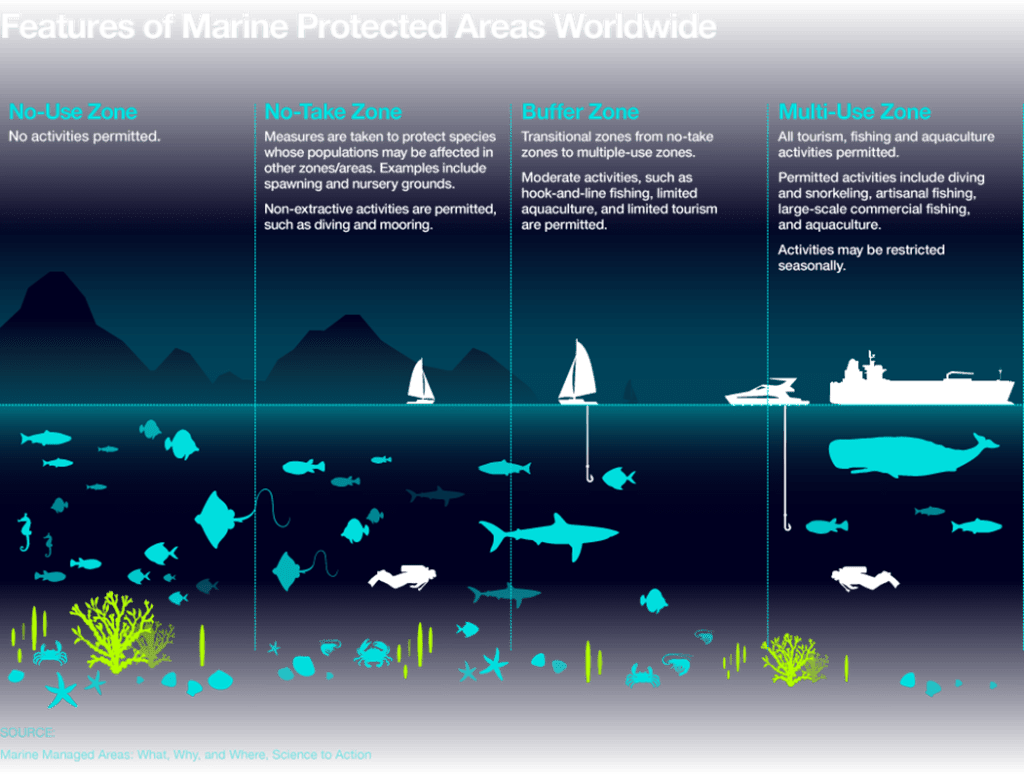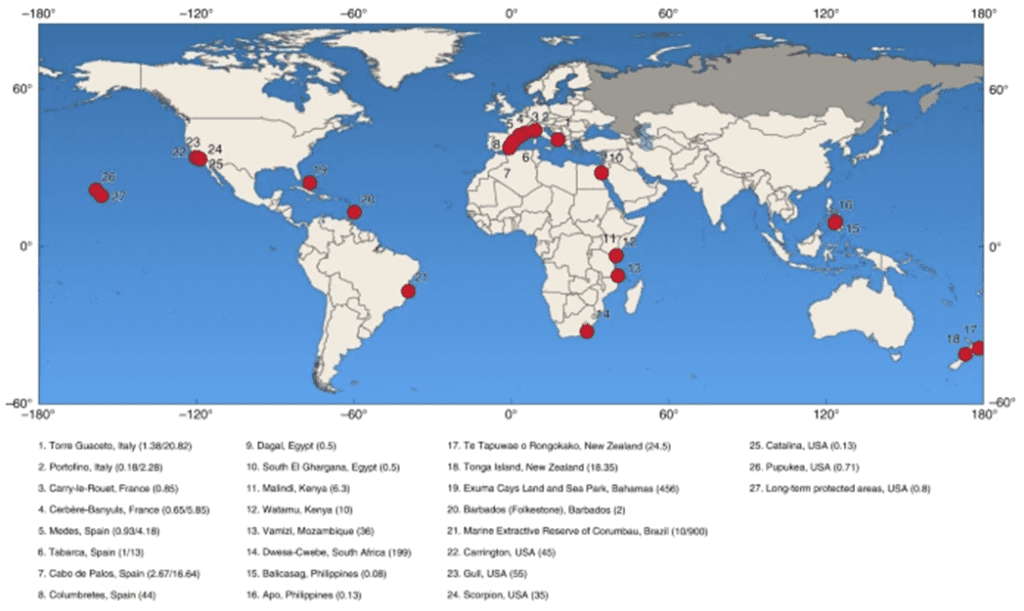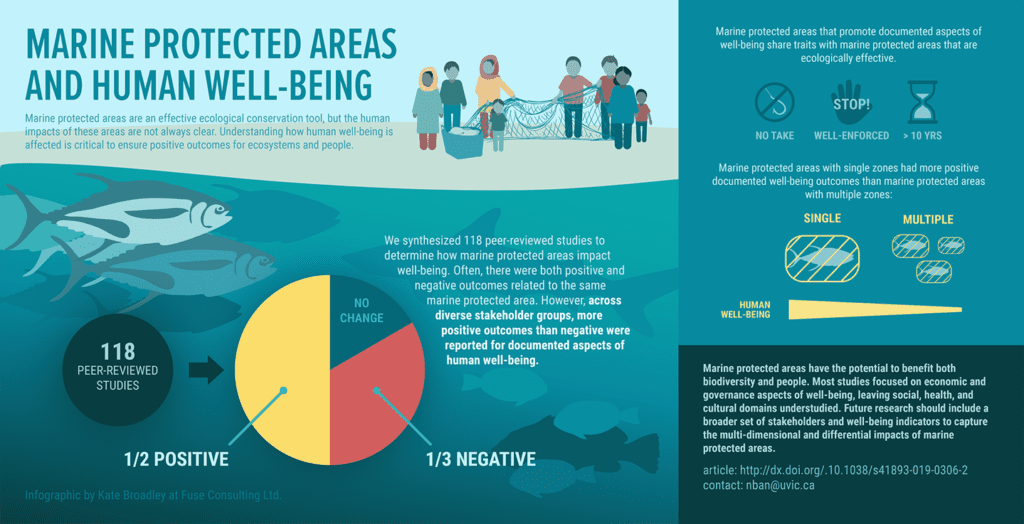Marine protected areas (MPAs) are areas of seas, oceans or estuaries that are managed and regulated for a number of different purposes. Usually, for biodiversity conservation, as they limit or disallow fishing and aquaculture activities within the boundaries of the MPA. Here, we will go through some of the more recent research surrounding MPAs. We will look at some non-material benefits of MPAs, how they can be designed to maximize their effectiveness, and what they mean for the wellbeing of the local communities they impact.

A quick review of marine protected areas (MPAs)
Here is some of what was already known about MPAs prior to these studies:
- As of November 2021, 7.91% of the ocean has been designated as an MPA
- However, only 2.8% of the ocean is considered fully or highly protected from fishing impacts
- Although biodiversity targets have been set for expanding the amount of ocean area that is protected, scientists warn that focusing solely on quantity can bring about ‘perverse outcomes’, and that a greater focus should be placed on the quality of protected areas

Study 1: Evidence for cultural ecosystem services from MPAs
There are many types of services provided by ecosystems that benefit human welfare. Protected areas are a strategy to maintain these services for our own wellbeing – and some of those services protected by MPAs are listed above. However, one type of ecosystem service that had not been studied comprehensively are cultural ecosystem services (CES’s).
CES’s are non-material benefits provided to society by ecosystems – which can include recreation, aesthetic enjoyment, and mental health benefits. They are thus much harder to quantify than some other ecosystem services such as the production or regulation of nutrients. Many research and knowledge gaps still remain.
With this in mind, researchers from the University of Aberdeen in the UK compared the CES’s delivered by MPAs compared to non-protected control sites. Using social media sampling, they noted several key findings:
- People take and upload to social media more photos from inside MPAs than in non-MPA sites
- Photos taken from inside MPAs tend to be more nature and wildlife focused than those taken in control sites
- Photos taken from inside MPAs are more popular and described more positively than photos from control sites
The conclusion that the authors draw from these findings is that people ”preferentially visited MPAs to experience nature and wildlife” and that “MPAs deliver added CES’s”. Thus, in addition to the practical and environmental benefits provided by MPAs, there is now evidence that they may also provide mental health and recreational benefits to visitors and tourists.

The study was published in the journal One Earth.
Study 2: How to design an effective MPA
Not all MPAs are created equal – some perform better than others. Scientists from Tel Aviv University in 2021 conducted a meta-analysis using data from 27 no-take MPAs around the world to identify what factors drive this variation in MPA quality.
Specifically, the researchers analysed ‘edge effects’. These are ecological – often human-caused – stressors in the surroundings of a protected area that can degrade the environment within its borders. Terrestrial edge effects have been well studied before, but this paper fills a knowledge gap by empirically demonstrating the existence of marine edge effects as well.
The study found that edge effects affecting MPAs largely result from fishing activities – both illegal and legal. Edge effects can extend up to 1km within the borders of no-take MPAs, and MPAs that are smaller than 10km2 (which are the majority of MPAs) tend to show a particularly large edge-effect area.
The findings of this research demonstrate that the biomass within MPAs is around half of what it would be if it weren’t for edge effects. Taking action to lessen these edge effects therefore, is vital to improving the effectiveness of MPAs and achieving conservation goals.
Importantly, the authors note that MPAs that have buffer zones surrounding their no-take areas do not show edge effects. What this means for biodiversity goals is that no-take areas cannot allow unregulated fishing immediately outside their borders. Rather, regulations for fishing need to be enforced for the surrounding areas to protect the no-take area from edge effects.

The authors recommend that for MPAs to maximise their effectiveness, 3 relatively simple considerations should be implemented in their design:
- A size larger than 10km2,
- A precautionary buffer at least 1km wide around the borders of the no-take zone, and
- A circular design – this reduces the border areas (and thus the potential for edge effects) to a minimum
The study was published in the journal Nature Ecology & Evolution
Study 3: MPAs and human wellbeing
Environmental and conservation goals must be implemented with human wellbeing as a priority – particularly for the local communities around PA’s. In 2019, a team of international scientists conducted a comprehensive review of 118 peer-reviewed articles surrounding the research on MPA impacts on human wellbeing. Wellbeing aspects that were analysed included mainly economic and governance factors. This meant that there was a relative lack of study on social, health, and cultural factors of wellbeing.
They found that MPAs overall had a mix of positive and negative outcomes, though there were more reported positive than negative outcomes. Around half of wellbeing outcomes were reported to be positive and one-third were reported to be negative. The remainder noted no change either way.
The authors also analysed the factors that contributed to positive wellbeing outcomes from MPAs – which included:
- No-take MPAs
- Well enforced MPAs
- Old MPAs
- MPAs with single zones rather than multiple zones
In general, there tended to be overlap between the factors that make MPAs ecologically effective and those that promote positive human wellbeing. This is yet another reason to prioritise PA quality and not just focus on area-based targets.
Overall, the authors concluded that MPAs certainly have the potential to enhance both biodiversity conservation and human wellbeing. However, currently, many reported impacts of MPAs on humans are negative, prompting more efforts to design our conservation efforts around benefiting both people and nature.

The study was published in the journal Nature Sustainability.
MPAs are a vital tool to combat biodiversity loss and climate change. This new research shows that they can also provide CES benefits, how they can be spatially designed to maximise their effectiveness, and that they can improve human well-being if they are designed and managed properly.


